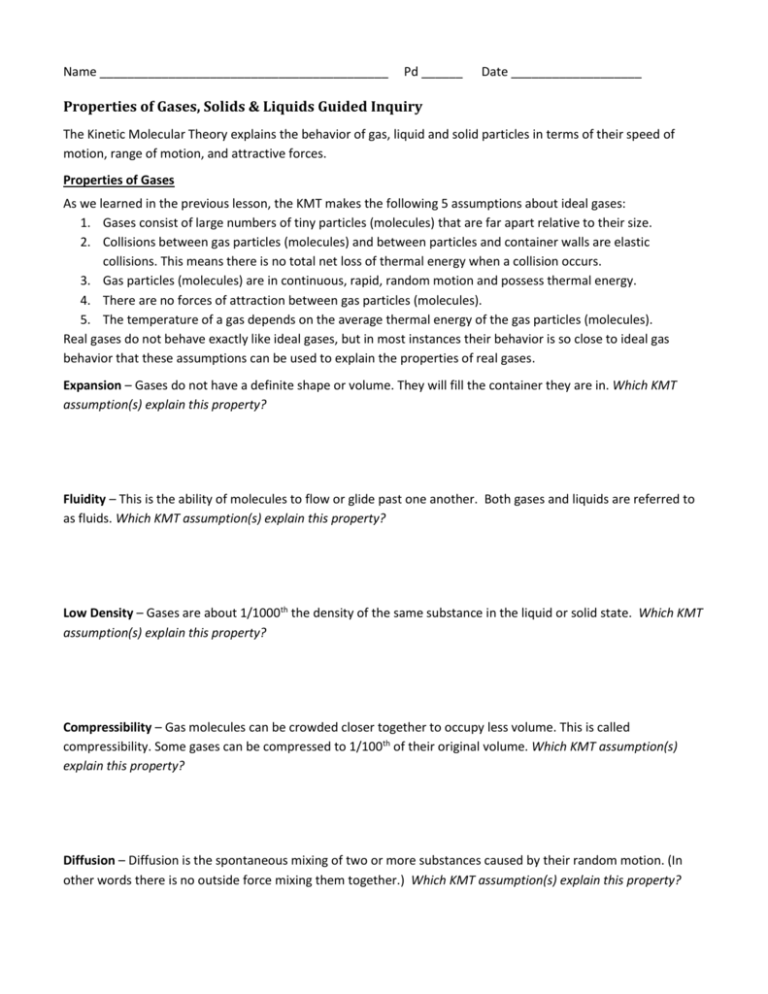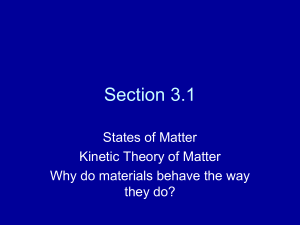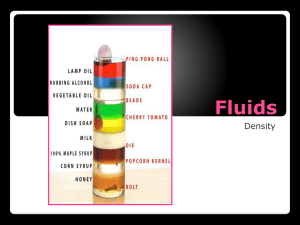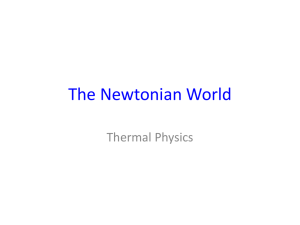Properties of Solids, Liquids & Gases Guided Inquiry
advertisement

Name __________________________________________ Pd ______ Date ___________________ Properties of Gases, Solids & Liquids Guided Inquiry The Kinetic Molecular Theory explains the behavior of gas, liquid and solid particles in terms of their speed of motion, range of motion, and attractive forces. Properties of Gases As we learned in the previous lesson, the KMT makes the following 5 assumptions about ideal gases: 1. Gases consist of large numbers of tiny particles (molecules) that are far apart relative to their size. 2. Collisions between gas particles (molecules) and between particles and container walls are elastic collisions. This means there is no total net loss of thermal energy when a collision occurs. 3. Gas particles (molecules) are in continuous, rapid, random motion and possess thermal energy. 4. There are no forces of attraction between gas particles (molecules). 5. The temperature of a gas depends on the average thermal energy of the gas particles (molecules). Real gases do not behave exactly like ideal gases, but in most instances their behavior is so close to ideal gas behavior that these assumptions can be used to explain the properties of real gases. Expansion – Gases do not have a definite shape or volume. They will fill the container they are in. Which KMT assumption(s) explain this property? Fluidity – This is the ability of molecules to flow or glide past one another. Both gases and liquids are referred to as fluids. Which KMT assumption(s) explain this property? Low Density – Gases are about 1/1000th the density of the same substance in the liquid or solid state. Which KMT assumption(s) explain this property? Compressibility – Gas molecules can be crowded closer together to occupy less volume. This is called compressibility. Some gases can be compressed to 1/100th of their original volume. Which KMT assumption(s) explain this property? Diffusion – Diffusion is the spontaneous mixing of two or more substances caused by their random motion. (In other words there is no outside force mixing them together.) Which KMT assumption(s) explain this property? Effusion – Effusion is the process of substances passing through a tiny opening. Which KMT assumption(s) explain this property? The ability of a gas to effuse through a small opening is proportional to its velocity. The faster the gas molecule is moving the faster it will pass through the opening. Two gas particles with different masses are in a container at the same temperature. Based on the thermal energy formula which gas will effuse the fastest? Properties of Liquids For a given substance, liquid particles are at a lower temperature than gases. According to the KMT, this means they have less thermal energy than gases. Therefore, liquid particles have a moderate speed of motion compared to gas particles’ rapid speed of motion. Liquid particles have less interaction energy than gases so the particles’ attractive forces significantly affect the range of motion. The particles’ interaction energy is strong enough that the particles can randomly move past each other, but the attractive forces are strong enough to limit their range of motion. Expansion – At a constant temperature, liquids do not spontaneously expand, which is seen by the fact that a liquid has a definite volume. Why don’t liquids spontaneous expand like gases? Fluidity – Liquids are fluid, which means they can flow or glide past each other. This is seen by the fact that liquids take the shape their container. How does KMT explain the fact that liquids are fluid? Relatively High Density – At normal atmospheric pressure, liquids are typically hundreds of times denser than the density of the same substance as a gas. How does KMT explain why liquids have a much higher density than gases? Relative Incompressibility – Liquids are relatively incompressible compared to gases. For example, at 20°C when liquid water is compressed by 1000 atm of pressure its volume only decreases 4%. Under the same conditions the water vapor volume will decrease by 99.9%. How does KMT explain the relative incompressibility of liquids? How do we benefit in our everyday lives from the relative incompressibility of liquids? Diffusion – Liquids diffuse, but at a much slower rate than gases. How does KMT explain this slower diffusion? (Remember diffusion is the spontaneous mixing of two or more substances caused by their random motion.) Effusion – Liquids do not effuse through openings. Why don’t liquids effuse? This may seem confusing because you can open a bottle of ammonia or perfume and eventually you can smell it throughout the entire room. What is happening is that some of the liquid molecules have enough energy to escape into the gas state. It is the gas molecules that are diffusing through the opening in the bottle, not the liquid molecules. Surface Tension – Surface tension is a force that tends to pull adjacent parts of a liquid’s surface together, thereby decreasing surface area to the smallest possible size. All liquids have surface tension. The amount of surface tension a liquid has is related to the strength of the particles’ attractive forces. Based on your lab experiment, rank the liquids from strongest attractive forces to weakest attractive forces? Capillary Action – Capillary action is the attraction of liquid molecules to the surface of a solid. This attraction is strong enough to overcome the forces of gravity. We observe this when roots transport water from the ground to the leaves of a plant or tree, and when the liquid climbs up the sides of a graduated cylinder to create a meniscus. Capillary action is also affected by the diameter of the tube (or root in the case of plants). The capillary action is greater for smaller diameter tubes than for larger diameter tubes. Based on your lab experiment, rank the papers in order of descending capillary action. Properties of Solids The kinetic molecular theory can be used to understand the physical properties of solids. For a given substance, solid particles are at a lower temperature than either the gas or liquid particles. Solid particles have the least thermal energy and interaction energy of the three states of matter. The particles have a low speed of motion and an extremely limited range of motion. The attractive forces are so much stronger than the interaction energy that solid particles vibrate in fixed positions close to each other, the particles cannot move past each other. Expansion – At a constant temperature, solids do not expand as evidenced by the fact that a solid has a definite volume. How does KMT explain why solids don’t expand at a constant temperature? Fluidity – Solids are not fluid. This is apparent by the fact that solids have a definite shape and do not take the shape of their container. How does KMT explain why solids are not fluid? Relative High Density – In general solids are the densest state of a substance. How does KMT explain this property? Which substance is the most important exception to the solid being the densest state of a substance and how do you know this substance is an exception to the rule? Relative Incompressibility – For practical purposes solids are considered incompressible. How does KMT explain this property? Give an example of how we rely on this property of solids in our lives. Low Rate of Diffusion – Solids can diffuse but at rates that are millions of times slower than liquids or gases. For example, if a zinc plate and copper plate are clamped together for a long time a few molecules will diffuse into each other. If it were liquid zinc and liquid copper the molecules would completely diffuse very quickly. How does KMT explain this property?








